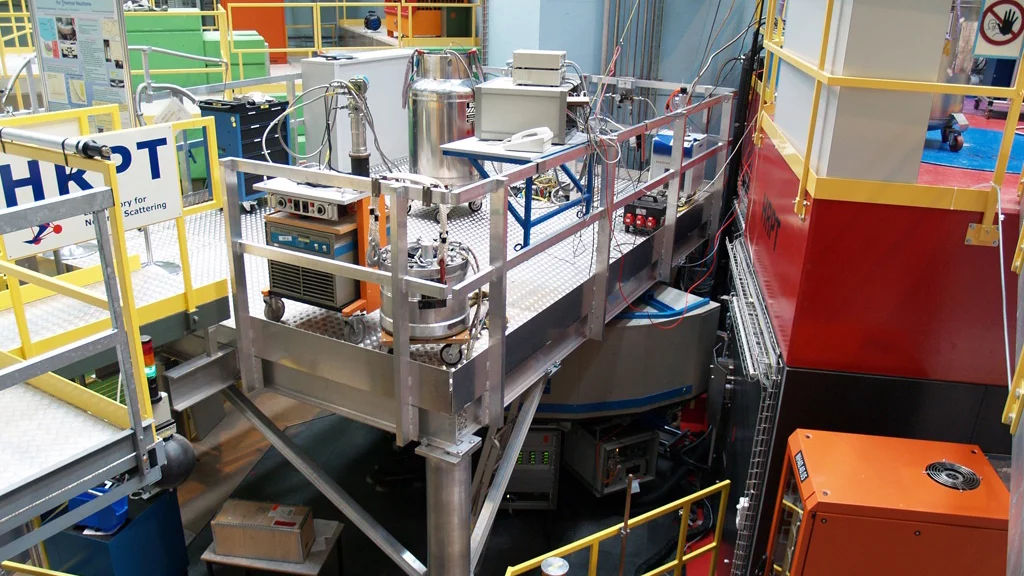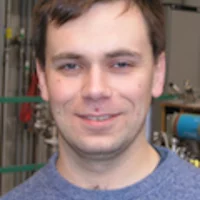The multidetector diffractometer HRPT [1] is designed as flexible instrument for efficient neutron powder diffraction studies - also for small sample sizes. High resolution (δd/d < 0.001) is achieved by thermal neutrons, large scattering angles of the monochromator and of the sample (up to 165°). By means of primary collimators, a secondary slit system and by appropriate choice of the sample diameter, resolution and intensity can be optimized. Wide range of neutron wavelengths λ = 1.04-2.96 Å is available. Due to the use of a large position sensitive (PSD) 3He detector , simultaneous measurements are possible within a scattering angle range of 160 degrees with angular step 0.1°. The detector can be positioned on air cushions also at intermediate positions and the angular step can be e.g. 0.05° or less. The detector can run in stroboscopic mode for the measurements of the crystal structures as a function of time the periodic processes (for example, charging/discharging) with maximal time resolution 10ms. An oscillating radial collimator suppresses Bragg peaks from the sample environment such as for cryostats, furnaces, magnets or high pressure cells (<14 kbar) and (<100 kbar). The HRPT instrument is also equipped with the computer controlled sample changer for eight (8) samples for room temperature, sample changer for four (4) and for five (5) samples with sample rotation for the temperature range 1.5 - 315 K. HRPT is complementary to the Cold Neutron Powder Diffractometer DMC, which is designed for high-intensity performance. More instrumental details and specifications can be found here.
Complementary to synchrotron X-ray powder diffraction studies, the applications of HRPT are high-resolution refinements of chemical and magnetic structures as well as phase analysis of novel materials. Because of the generally weak absorption, neutrons yield information on bulk properties (average over large sample volumes) and permit in a nondestructive way the detection of lattice distortions, defects and internal microstrains. Also real-time (in-situ) investigations of chemical or structural changes and of magnetic phase transitions in crystalline, quasicrystalline, amorphous and liquid samples including technically interesting new materials are possible. Examples are precise localization of light elements (isotopes) such as hydrogen (deuterium) in metal deuterides (metal hydrogen storage systems) or zeolites, oxygen in high-Tc and CMR systems or 7Li in ionic conductors etc. Another advantage may be the distinction between neighboring elements in the periodic table such as Mn (negative neutron scattering amplitude b) and Fe (b > 0). Moreover, nuclear neutron scattering yields in case of a sufficiently large range of momentum transfer accurate information on average thermal motion (harmonic and anharmonic temperature factors). These applications are important in crystallography, condensed matter physics, chemistry and materials science. In particular, profile analysis as a function of external parameters such as temperature is standard in neutron diffraction.
First experiments were performed on HRPT in 1999, and user operation was started in April 2000.
The HRPT instrument is used not only for academical science in frame of user policy program, but also a limited amount of HRPT beam time is sold to industrial companies. Some companies cannot disclose the details of their research for confidentiality reasons and in this case HRPT beam time can be bought skipping the usual proposal evaluation procedure. For instance, in 2009 several days of HRPT had been bought by "Toyota Europe" company for the research in the field of new materials for energy storage.
Reference
[1] P. Fischer et al., Physica B 276-278, 146 (2000)


